Anti-aircraft artillery of South Korea
Air Defense of the Republic of Korea... Like most of the armies of the US allies, the South Korean air defense units of the ground forces were equipped with American-made equipment and weapons until the early 1990s. After the conclusion of an armistice with the DPRK in 1953, the basis of the military air defense of the South Korean army for a long time was anti-aircraft weapons created during the Second World War: 90-mm M2 guns and 40-mm Bofors L60 assault rifles. To combat air targets at low altitude, 12,7-mm Browning M2 machine guns and 12,7-mm quadruple mounts with an electric guidance drive M45 / M55 Maxson Mount, which were used in the towed version and for installation on vehicles, were intended. The 90-mm M2 anti-aircraft guns were in operation until the end of the 1980s, and the 40-mm Bofors in South Korea were finally written off about 10 years ago.
After the adoption of the 20-mm six-barreled anti-aircraft guns "Vulcan" in 1978, the withdrawal of the quad ZPU M45 Maxson Mount and M55 to the reserve began. However, a number of 12,7-mm anti-aircraft guns as a means of strengthening the air defense of infantry battalions were operated until the mid-1990s.
The M45 Maxson Mount anti-aircraft machine gun was developed in 1943. ZPU weight in firing position - 1087 kg. The firing range at air targets is about 1000 m. The rate of fire is 2300 rounds per minute.
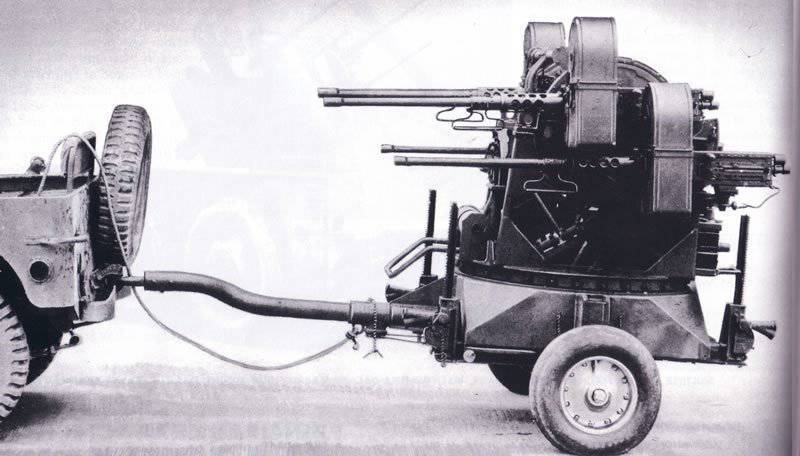
Towed anti-aircraft machine gun mount M55
The lighter version on a two-axle trailer is known as the M55. At the firing position, to make the installation more stable, special supports were lowered to the ground from each corner of the trailer. The trailer also housed batteries for the anti-aircraft gun power supply and a charger for them. Guidance was carried out using electric drives. The targeting drive motors were powerful, capable of withstanding the heaviest loads. Thanks to electric drives, the installation had a guidance speed of up to 60 deg / s.
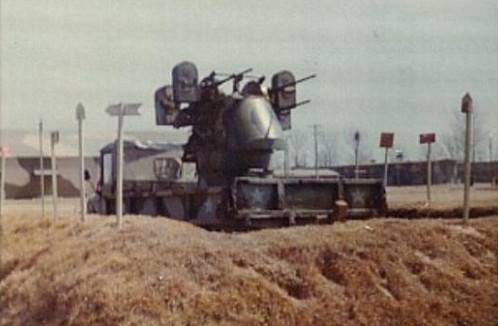
12,7 mm quadruple ZPU in the back of a truck
To increase mobility and reduce the time of transfer to a combat position, many quad 12,7-mm ZPUs available to the South Korean and American armies were installed on army off-road trucks.
In addition to its direct purpose, quad mounts of large-caliber machine guns were a very powerful means of fighting manpower and lightly armored vehicles, earning the unofficial nickname "meat grinder". There is information that some 12,7-mm installations located in the immediate vicinity of the demilitarized zone have survived at stationary fortified strongholds to this day. Large-caliber quad machine guns can no longer be considered a modern means of air defense, but they are still effective against manpower and lightly armored targets.
Until the early 1970s, anti-aircraft cover for military and transport convoys in the armed forces of the Republic of Korea was provided by the Multiple Gun Motor Carriage M16 ZSU. The self-propelled unit created on the basis of the M3 half-track armored personnel carrier was armed with a 12,7 mm Maxson Mount ZPU. The car weighing about 9,8 tons could move along the highway at speeds up to 70 km / h. The power reserve was 280 km. Crew - 5 people.
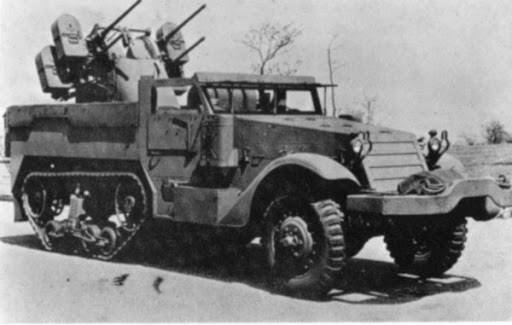
Self-propelled anti-aircraft gun M16
The M16 self-propelled anti-aircraft gun had very high characteristics for its time and was the most numerous type of American ZSU during the Second World War. It was used in both the European and Pacific theaters of operations.
The self-propelled unit actively participated in the Korean War and remained in service with the American army until 1958. In the post-war period, a large number of ZSU M16 were transferred to the US allies. South Korea received more than 200 of these machines, which were in operation until the first half of the 1980s.
The answer to the qualitative strengthening of the North Korean military aviation in the late 1970s, the South Korean army saw the appearance of 20-mm self-propelled anti-aircraft guns M163 Vulcan based on the M113 armored personnel carrier and towed 20 mm M167 Vulcan. The ZU M167 and ZSU M163 use the same 20-mm gun mount with an electric drive, created on the basis of the M61 Vulcan aircraft cannon, capable of firing at a rate of fire of 1000 and 3000 rds / min. Effective firing range at fast-moving air targets - up to 1500 m.
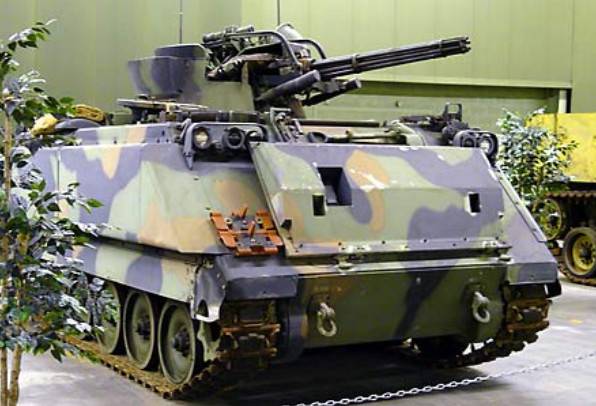
Self-propelled anti-aircraft gun M163
Self-propelled units are used to escort motorized rifle and tank subunits, and towed for air defense of stationary objects and places of concentration of troops.
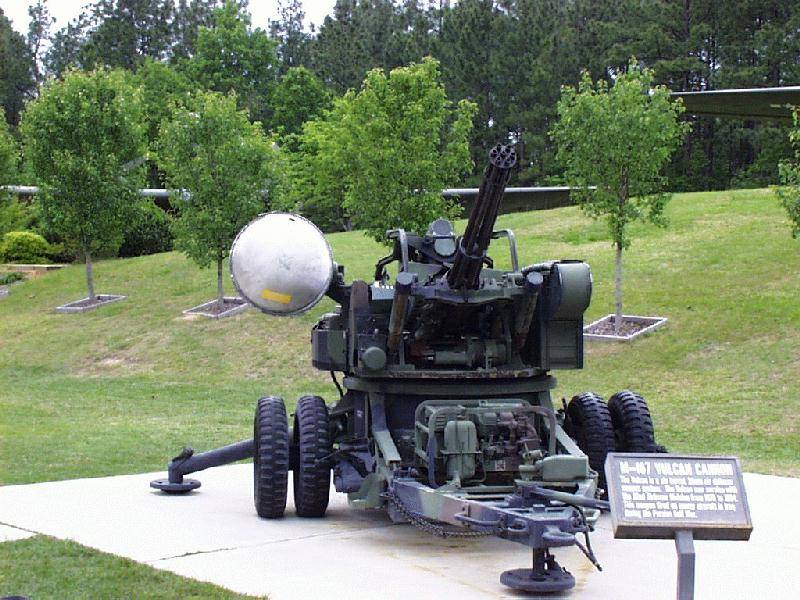
Towed anti-aircraft installation M167
The batteries of the M167 ZU and M163 ZSU received external target designation from the AN / TPS-50 radars. The station, located on a truck chassis and coupled with "friend or foe" equipment, had an instrumental detection range of up to 90 km. However, the AN / TPS-50 radar in terms of mobility and deployment-folding time was much inferior to military air defense systems. For this reason, the station could not provide constant radar control of the airspace during the redeployment of troops. In this regard, the calculations of anti-aircraft artillery more often relied on visual detection of air targets.
The sighting equipment of 20-mm installations included a radar coupled with an analog computer, which made it possible to accurately determine the distance to the target and its speed. An optical sight with manual data entry was used as a backup. When the charger M167 was operating at the position, it was powered by a cable from an external power supply source.
Taking into account the tense situation on the Korean Peninsula, the crews of the towed M167 and self-propelled M163 20-mm anti-aircraft guns often train in shooting at ground targets.
In the late 1980s, licensed production of 20-mm six-barreled Vulcan anti-aircraft guns was established in the Republic of Korea. The basis for the Korean 20-mm SPAAG K263A1 was the K200 KIFV tracked armored personnel carrier. This vehicle, created by Daewoo Heavy Industries, had much in common with the American M113 armored personnel carrier and was mass-produced from 1985 to 2006. Currently, the US-made ZU M167 and ZSU M163 in the South Korean army have been completely replaced by 20-mm anti-aircraft guns built in the Republic of Korea.
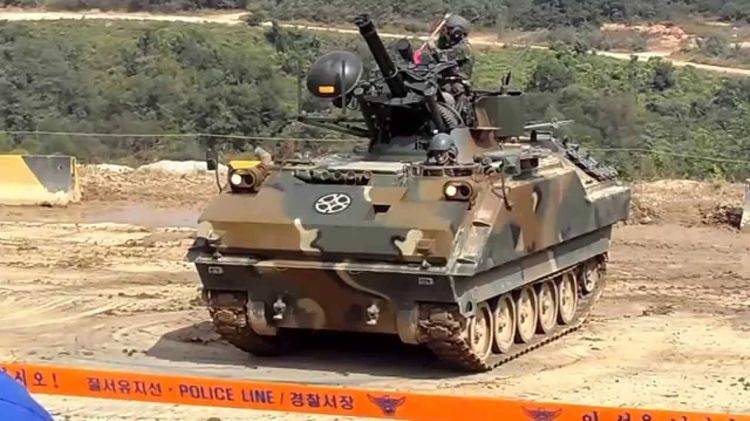
Anti-aircraft self-propelled gun K263A1
The K263A1 self-propelled gun is armed with an artillery unit and is equipped with sights, which were originally created for the KM167A3 towed anti-aircraft gun. This modification is equipped with an improved radar sight and is quickly transferred from the traveling position to the combat position.
The towed unit, in addition to improving reliability and performance, has electronics with an increased MTBF and is better suited for long-term duty at a firing position.
In the 21st century, South Korean towed and self-propelled 20-mm six-barreled units underwent a major overhaul and modernization program. In addition to the radar rangefinder, the sighting equipment includes a television camera with a night channel and a laser rangefinder developed by LG Innotec.
Although the range of effective fire has not changed, the capabilities of independent search and firing at air and ground targets in the dark have expanded. Using a television camera coupled with a laser rangefinder allows you to fire without a radar channel.
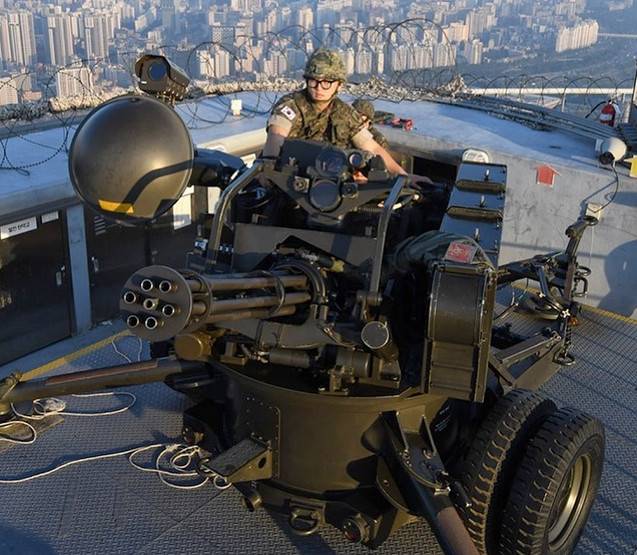
Upgraded anti-aircraft gun KM167A3 at firing position
Self-propelled and towed 20-mm Volcanoes are quite numerous in the army of the Republic of Korea. According to the reference data, there are about 1000 towed KM167A3 and about 200 self-propelled K263A1 in the air defense of the SV RK.
If the K263A1 self-propelled guns attached to the tank regiments are in technical parks most of the time, a significant part of the towed KM167A3 anti-aircraft guns are permanently deployed in positions in the immediate vicinity of the demilitarized zone, in the vicinity of air bases and large garrisons.
The issuance of target designation to self-propelled and towed installations "Vulkan" is currently assigned to the mobile radar TPS-830K. The station on the chassis of a heavy truck, operating in the 8-12,5 GHz frequency range, is capable of detecting an air target with an RCS of 2 sq. m at a distance of up to 40 km.
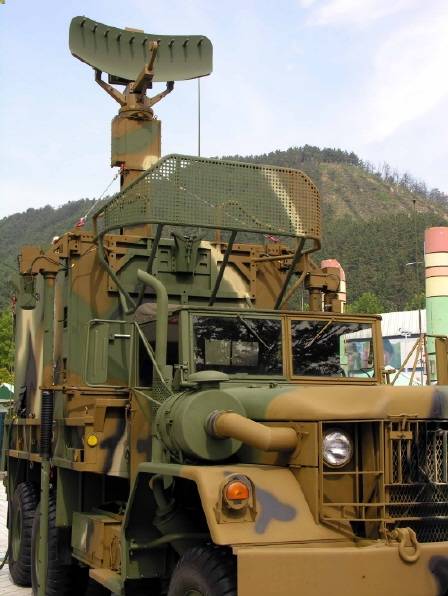
Radar TPS-830K
The 20-mm Vulcan anti-aircraft guns have a high fire density, but are capable of striking air targets at a relatively short range. The 40-mm Bofors anti-aircraft assault rifles can theoretically provide a greater range and height of destruction, but with a combat rate of fire of 120 rounds / min, they did not give an acceptable probability of hitting rapidly moving air targets and did not have an effective fire control system. Due to the need for weapons more long-range than the 20-mm "Vulcan", and more rapid-fire than the 40-mm "Bofors", South Korea in 1975 purchased from Switzerland 36 paired 35-mm anti-aircraft guns Oerlikon GDF-003. The battery fire, in which there are four anti-aircraft guns, is controlled by the Skyguard FC radar.
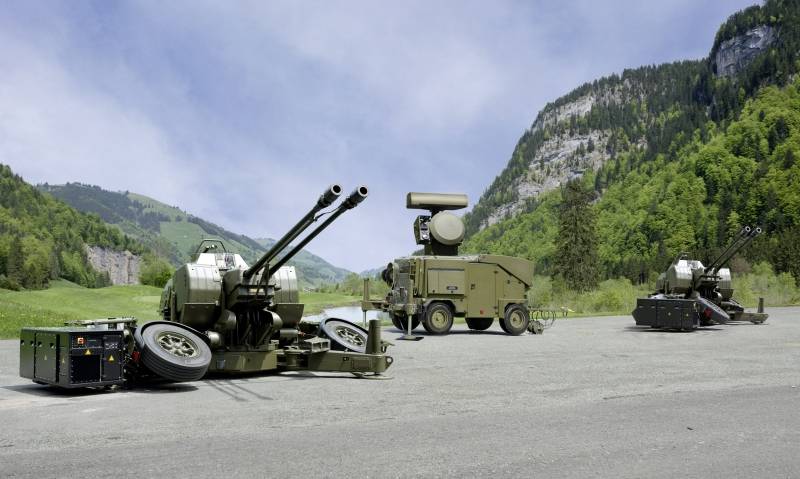
35-mm anti-aircraft guns and radar fire control Skyguard
The towed 35-mm artillery anti-aircraft gun Oerlikon GDF-003 weighs 6700 kg in combat position. Sighting range at air targets - up to 4000 m, reach in height - up to 3000 m. Rate of fire - 1100 rds / min. The capacity of the charging boxes is 124 shots.
Each 35-mm twin anti-aircraft gun is interfaced by cable lines with the Skyguard FC radar. The anti-aircraft fire control station, controlled by a crew of two, is located in a towed van, on the roof of which a rotating pulse Doppler radar antenna, a radar rangefinder and a television camera are installed. It is possible to automatically enter data into the sighting devices of each anti-aircraft gun and to automatically aim them at the target without the participation of the calculation. In addition to direct fire control of the anti-aircraft battery at any time of the day, it provides an overview of the airspace at a distance of up to 40 km.
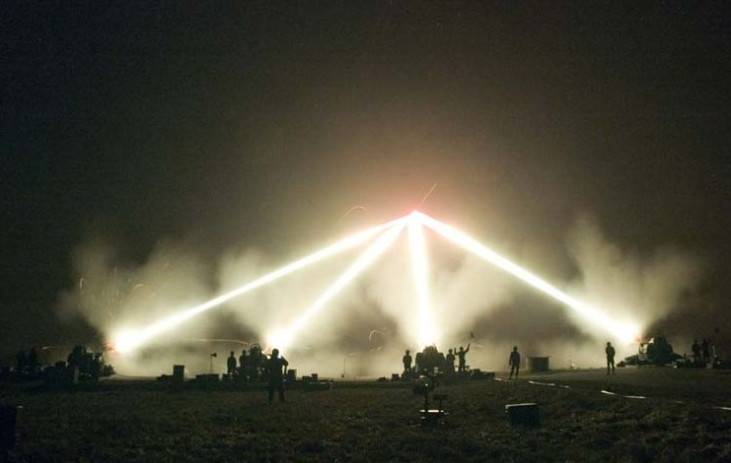
Taking into account the fact that all the paired artillery mounts of the anti-aircraft battery are aimed at one point during firing, 73 high-explosive 35-mm armor-piercing projectiles with a total weight of 40 kg can be fired at the target in one second.
According to information published in South Korean sources, Oerlikon GDF-003 anti-aircraft batteries are permanently stationed around Seoul. All positions are located on high ground and equipped in engineering terms. The anti-aircraft guns themselves, fire control radars and autonomous electric generators are installed in concreted caponiers, and there are well-protected bunkers for personnel and ammunition.
In the late 1980s, the DPRK Air Force received Su-25 jet attack aircraft. The 20-mm Vulcan anti-aircraft guns available in South Korea are ineffective against these well-protected combat aircraft. In addition, the South Korean military was not satisfied with the relatively small firing range of 20-mm anti-aircraft guns, which in this respect are not much superior to 12,7-mm machine guns.
The creation of a self-propelled anti-aircraft gun, armed with two 30-mm cannons, was completed in South Korea in 2000. After practical test firing at the range, the need to refine the aiming and search equipment was revealed. The official adoption of the K30 Biho ZSU took place in 2007.
The self-propelled anti-aircraft gun K30 Biho on the chassis of the tracked BMP K200 has a curb weight of 26,5 tons. Diesel engine with a capacity of 520 hp. provides speeds up to 65 km / h. In store down the highway - up to 500 km. The crew consists of three people: commander, gunner and driver. The armor protection of the K30 Biho provides protection against small arms fire and artillery fragments.
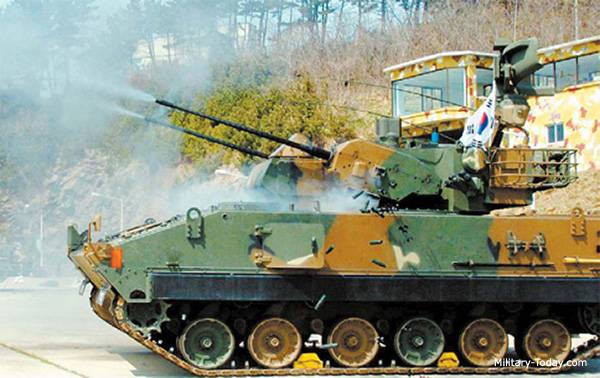
The ZSU K30 Biho is equipped with two 30-mm KKCB cannons manufactured by S&T Dynamic (licensed version of the 30-mm KCB cannon manufactured by Rheinmetall Air Defense), the total rate of fire of which is 1200 rounds / min. Each cannon's charging crates contain 300 ready-to-use rounds. High-explosive incendiary projectiles with an effective range of up to 3000 m are used to combat air targets. Armor-piercing incendiary projectiles are used to fire at ground targets. Turret traverse speed - 90 deg / sec, electric drive (auxiliary - manual). The elevation angles of the guns are from -10 ° to + 85 °.
Surveillance radar, optoelectronic tracking system, laser rangefinder, thermal imaging sight, high-precision digital fire control system are used to detect air targets, measure range, flight speed and aiming guns. Radar detection range - up to 20 km. The passive optoelectronic station is capable of seeing a jet aircraft at a distance of more than 15 km.
Currently, the South Korean army has 176 K30 Biho SPAAGs. In 2013, a combat performance enhancement program was launched, under which the vehicles began to be equipped with KP-SAM Shin-Gung short-range anti-aircraft missiles. Each ZSU additionally received two containers, which are equipped with two missiles.
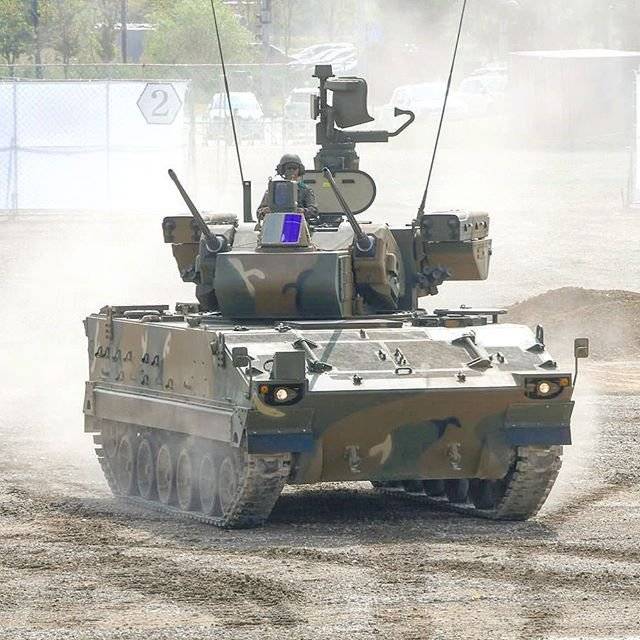
The LIG Nex1 KP-SAM Shin-Gung anti-aircraft missile is equipped with a two-color (IR / UV) seeker and is fully autonomous after launch. The maximum firing range is 7 km. Ceiling - 3,5 km.
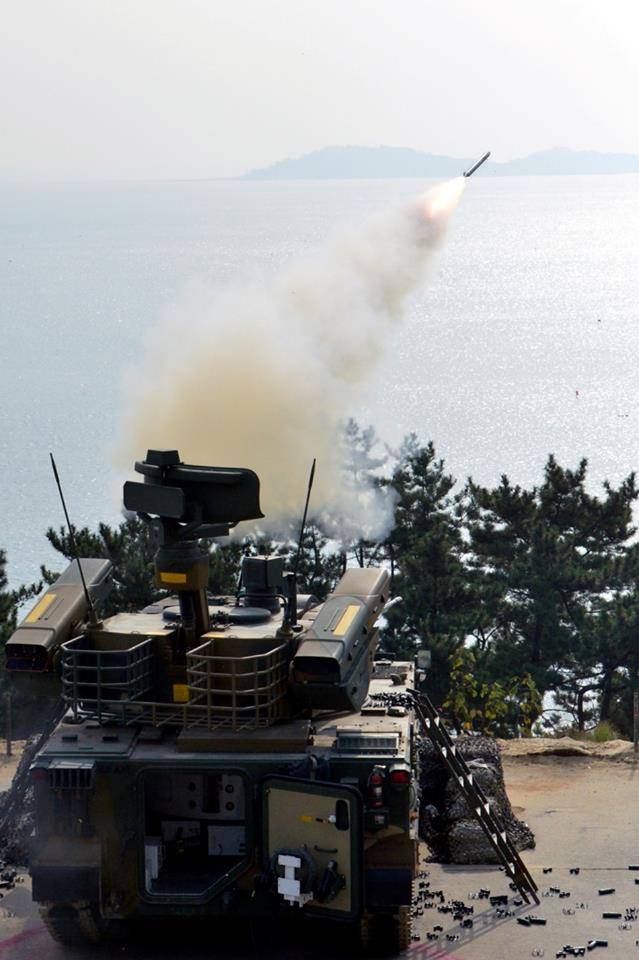
The upgraded self-propelled anti-aircraft gun with combined cannon and missile armament received the designation K30 Hybrid Biho. After the introduction of anti-aircraft missiles into the armament of the ZSU, the firing range has more than doubled and the probability of hitting air targets has significantly increased.
In 2019, the Defense Procurement Program Administration (DAPA) announced the creation of the AAGW ZSU based on the Hyundai Rotem K808 wheeled armored personnel carrier with an 8 × 8 wheel arrangement, which entered service with the army in 2017.
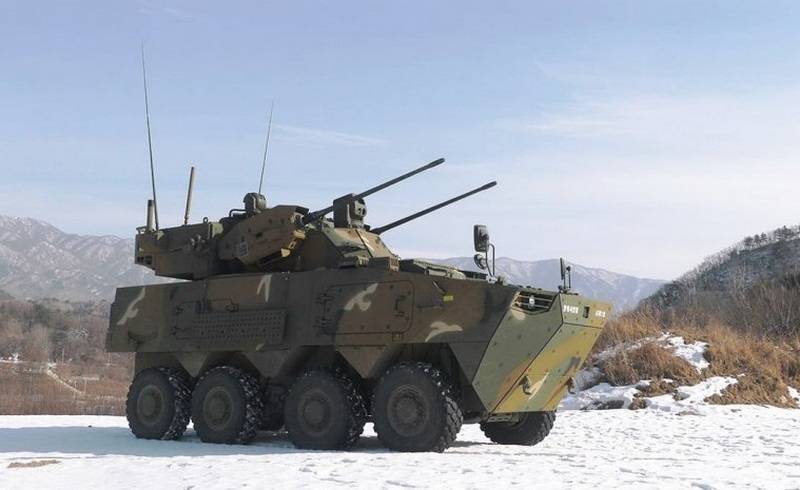
Anti-aircraft self-propelled gun AAGW
The armor protection of the K808 armored personnel carrier in the frontal projection provides resistance to 14,5-mm bullets at a distance of more than 300 m. The side armor must hold armor-piercing rifle caliber bullets. Diesel engine with 420 hp. accelerates a car weighing 18 tons to 100 km / h. The power reserve is up to 700 km. Crew - 3 people.
The new anti-aircraft gun is armed with 30 mm KKCB cannons. The use of radar detection is not provided and it is supposed to do with passive optoelectronic search and sighting systems. This, along with the use of a wheeled chassis, should reduce the purchasing and operating cost of the new anti-aircraft self-propelled gun, which in the future will replace the 20-mm K263A1 Vulcan SPAAG in the army.
The ending should ...
- Linnik Sergey
- Air defense of the Republic of Korea. Airspace control radar systems and missile systems of object air defense and missile defense
Fighter aircraft of South Korea
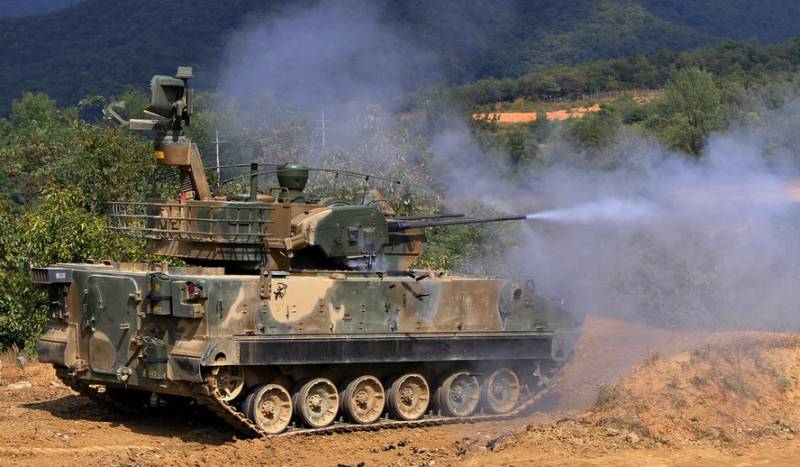
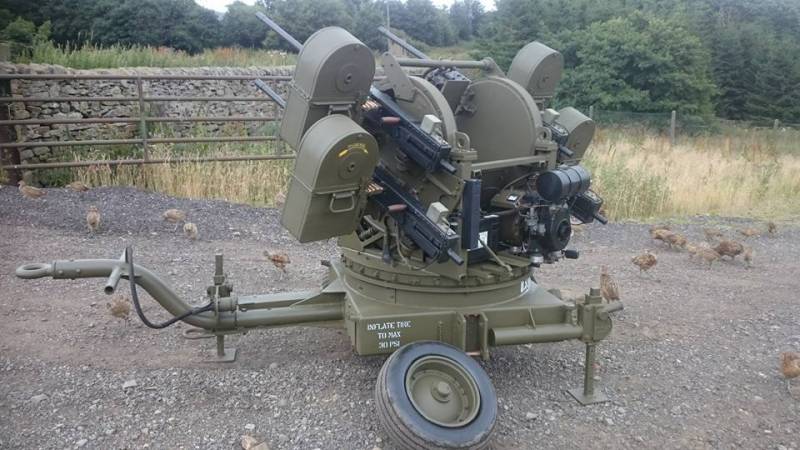
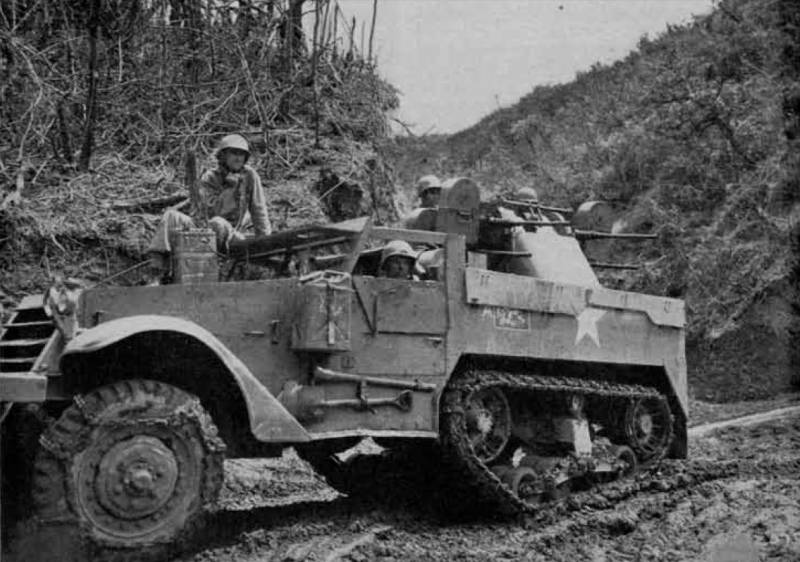
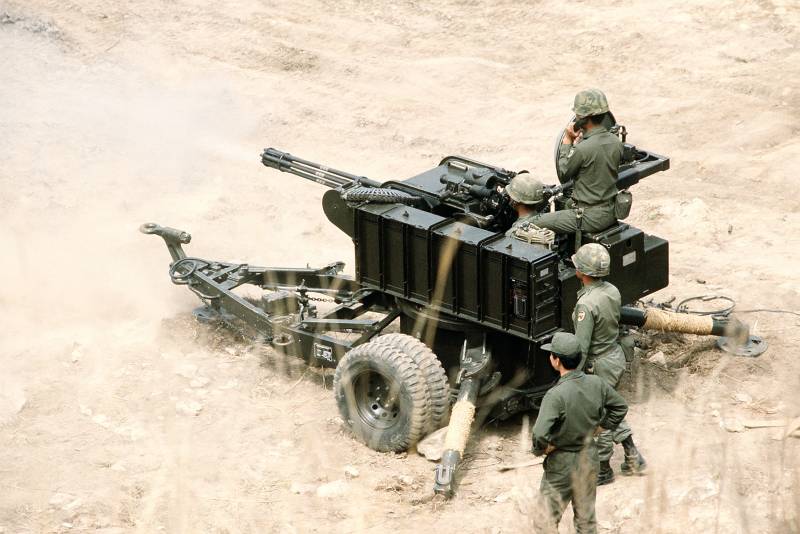
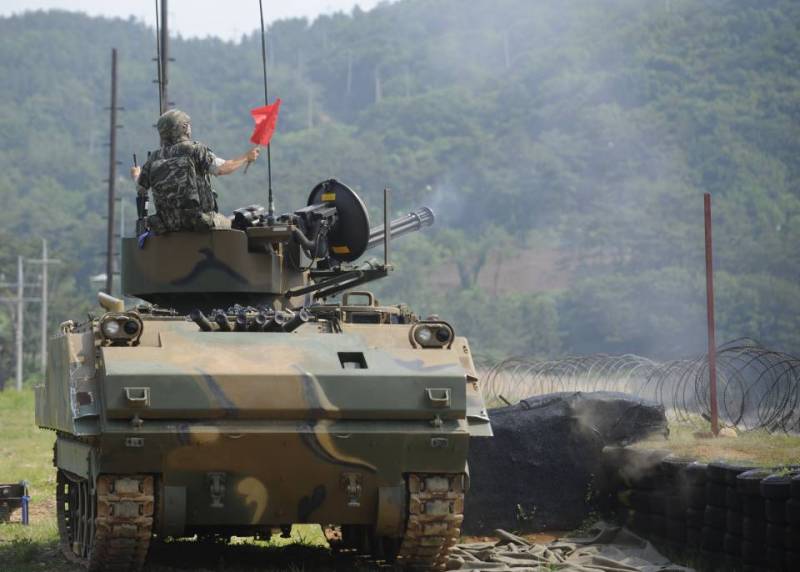
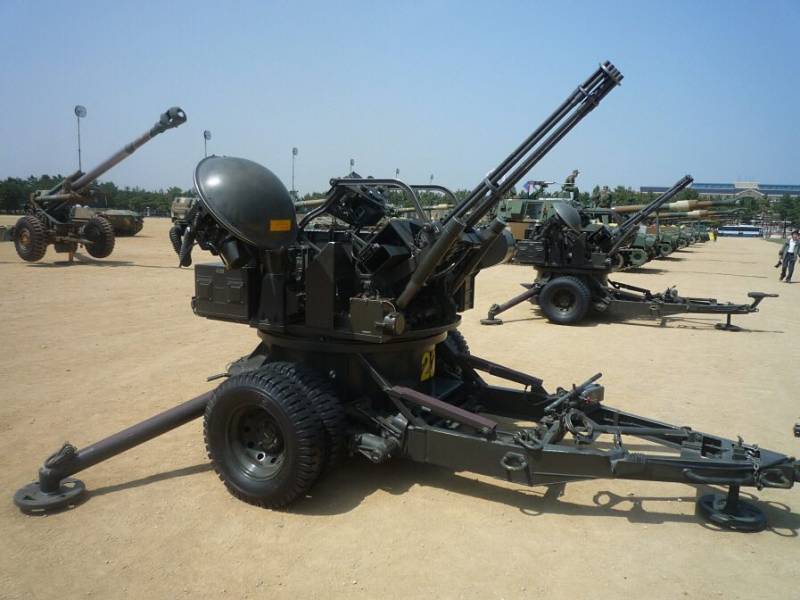
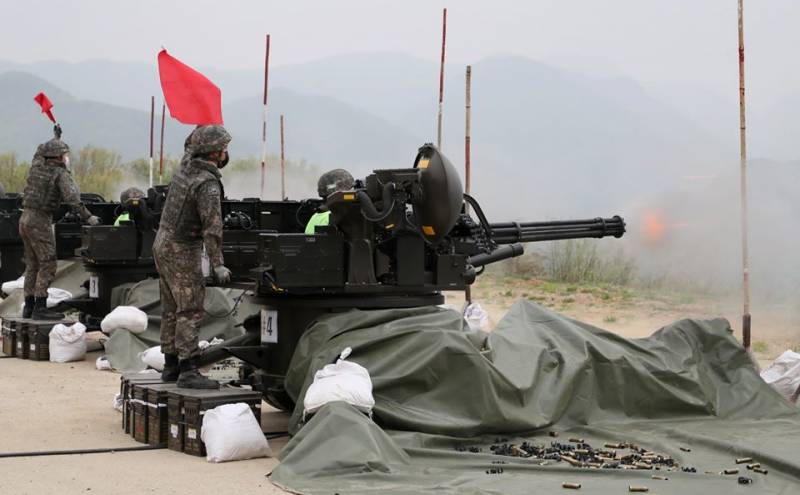
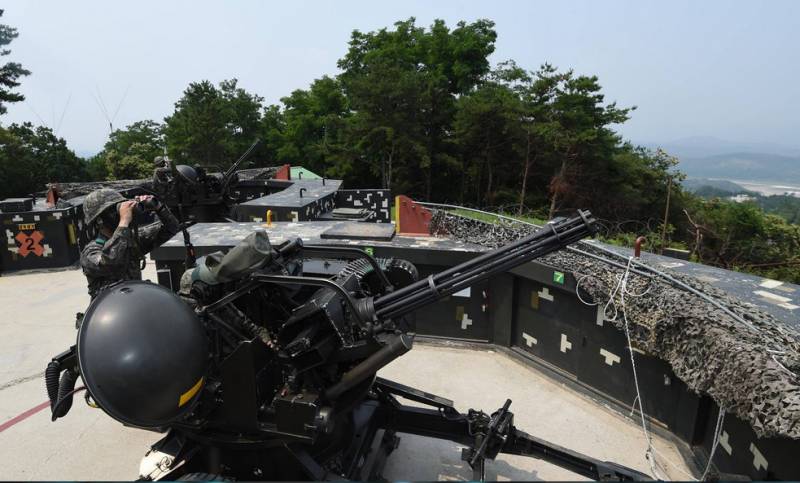
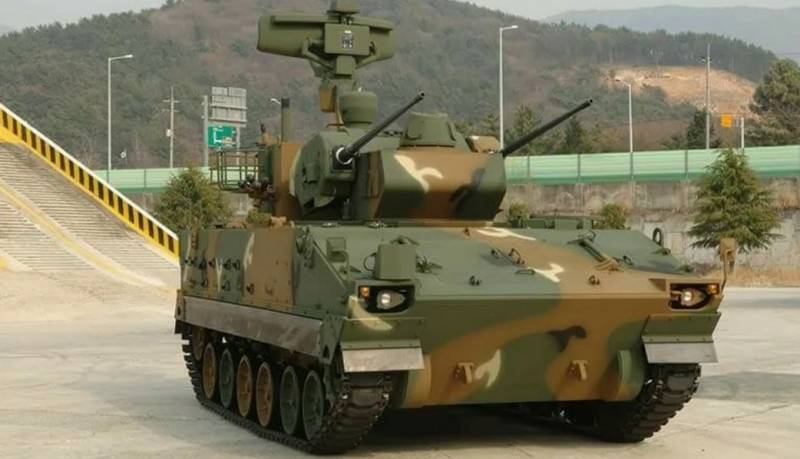
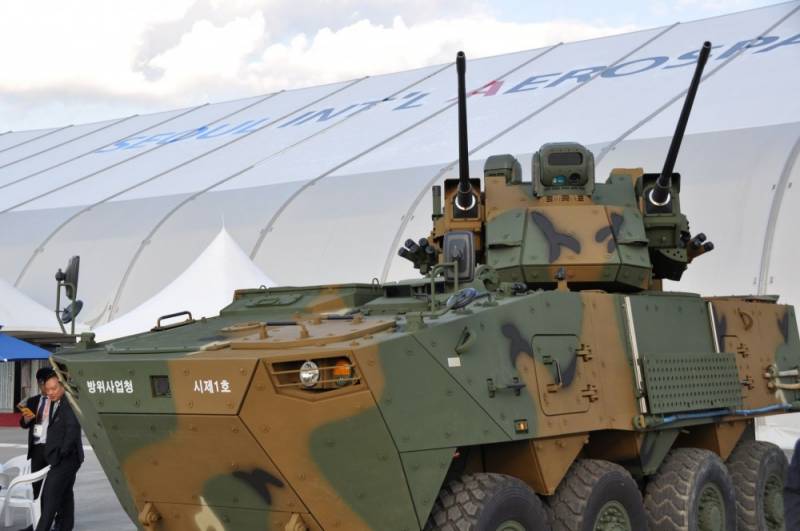
Information